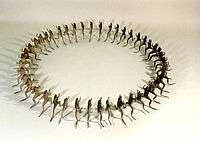María Fernanda Cardoso
María Fernanda Cardoso (born 1963) is a Colombian Australian artist, sculptor and illustrator.[1][2] Her contemporary art references many types of ready-made material, including plastic, trash, plants, dried and living animals, bones and styrofoam.[3] One of her most famous art installations was a flea circus that featured live cat fleas.[4] Her works have been featured in several museums internationally in Europe, the Americas, and Australia, and have won several awards.[5] She resides in Sydney.
María Fernanda Cardoso | |
|---|---|
| Born | 1963 (age 56–57) |
| Nationality | Colombian / Australian |
Notable work | Cardoso Flea Circus, Cementerio—Vertical Garden |
| Website | mariafernandacardoso |
Biography

In the early 1980s, Cardoso studied architecture and the visual arts at the University of the Andes in Bogotá. She moved to New York in 1987 to attend the Graduate Sculpture Program at the Pratt Institute. In 1990, she graduated with a Master of Fine Arts in Sculpture and Installation at Yale University.[6]
In 2000, the Museum of Modern Art in New York commissioned her to create a major installation for their millennium show, "Modern Starts". Here she installed 36,000 plastic lilies in a 125-foot long wall, which subsequently toured museums throughout the United States. In 2003, she represented Colombia at the Venice Biennale, exhibiting a large installation of starfish woven together into a submarine landscape called "Woven Water".[7]
Cardozo moved to Sydney, Australia, in 1997. She did a solo exhibition in 2011 at Melbourne's Arc One gallery centered on the genitalia of male insects. The exhibit was titled 'It's not size that matters, it is shape'. The following year, she created The Museum of Copulatory Organs for her doctoral project in 2012, which culminated in a Ph.D. from Sydney College of the Arts.[6]
Cardoso Flea Circus
Cardoso created a flea circus that included the following "performers" and "stuntfleas": Harry Fleadini, an escape artist; Samson and Delilah, fleas that lifted cotton ball weights; Teeny and Tiny, tightrope walkers; Pipita and Pepon, a flea couple who pushed luminescent balls on a wire; and Brutus, who pulled a locomotive.[4] Cardoso guided the behavior of the fleas by reward; when they behaved as desired, she let them feed directly on her blood.[8] As Cardoso explained, "It's one of the hardest thing in life to train fleas, it took six years and it requires a lot of patience, no one knew how to train fleas anymore".[6]
The first public performance of the Cardoso Flea Circus took place in October 1996 at San Francisco's Exploratorium.[9] Because of the size of the fleas, she collaborated with Ross Rudesch Harley to add audio and video for a larger projection. It was recently acquired by the Tate Modern.
Other notable works
"Cementerio—Vertical Garden" This is a serie of unique installations pieces made of artificial flowers placed as if growing horizontally from the wall over funerary stones outlined in pencil.[10] The pieces are made with a group plastic flowers and pencil, and was exhibited and developed by the artist from 1990 to 1999. This kind of installations are currently in the most important art collections worldwide as Museum of Modern Art (MoMA) in New York, Colección Patricia Phelps de Cisneros in Caracas, Colección Diane and Bruce Halle in Arizona, Colección D.O.P. in Madrid, Perez Art Museum in Miami, San Francisco Museum of Modern Art, California, among others institutions of great importance worldwide.
"Dancing Frogs" is an assembly of dried dead frogs connected by a circular wire. The frogs appear to be spinning in circles as if in a ritual dance. The piece explicitly references the representations and indigenous symbols of the Muisca, as the circle and the frogs were part of this Pre-Hispanic symbolism.[11]
References
- Thomas Riggs; N. Y.) Association of Hispanic Arts (New York; Association for Latin American Art (2002). St. James Guide to Hispanic Artists: Profiles of Latino and Latin American Artists. Cengage Gale. ISBN 978-1-55862-470-2.
- Isabel Schon (1 January 1993). Books in Spanish for Children and Young Adults: An Annotated Guide. Scarecrow Press. p. 37. ISBN 978-0-8108-2622-9.
- Carlos Arturo Fernández (1 January 2007). Arte en Colombia, 1981–2006. Universidad de Antioquia. pp. 73–. ISBN 978-958-714-017-0.
- John Fullerton; Jan Olsson (2004). Allegories of Communication: Intermedial Concerns from Cinema to the Digital. Indiana University Press. p. 288. ISBN 978-0-86196-651-6.
- Germán Rubiano Caballero (2001). Art of Latin America, 1981–2000. IDB. p. 15. ISBN 978-1-931003-02-5.
- "Professor Maria Fernanda Cardoso and the Museum of Copulatory Organs". ABC Australia. Retrieved 26 October 2013.
- Glenn Barkley (2012). Volume One: MCA Collection. MCA Store. p. 208. ISBN 978-1-921034-54-1.
- Giovanni Aloi (15 December 2011). Art and Animals. I.B.Tauris. p. 128. ISBN 978-1-84885-525-0.
- María Fernanda Cardoso; Museum of Contemporary Art (Sydney, N.S.W.) (2003). Zoomorphia: Maria Fernanda Cardoso. Museum of Contemporary Art. ISBN 978-1-875632-84-8.
- Adam Geczy (15 July 2008). Art: Histories, Theories and Exceptions. Berg. p. 156. ISBN 978-1-84520-701-4.
- Óscar Mauricio Ardila Luna (2008). La imposibilidad de la naturaleza: arte y naturaleza en el arte colombiano contemporáneo, 1991–2003. Univ. Nacional de Colombia. p. 69. ISBN 978-958-701-922-3.
Further reading
- Mundine, Djon (June 2015). "Maria Fernanda Cardoso : mestizaje". Artlink. 35 (2): 30–32.